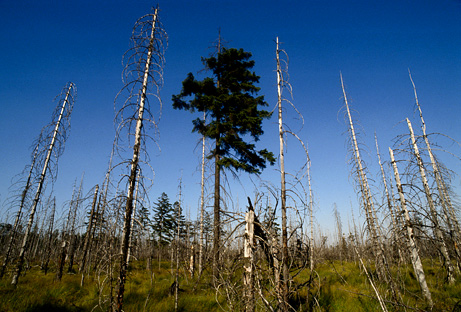
The finding confirms that even hardy trees didn't survive the Permian mass extinction, one of the most devastating losses of life Earth has ever known.
During the so-called Great Dying, more than 95 percent of marine species and 70 percent of land species disappeared, most likely victims of toxic gases spewed by a prolonged volcanic eruption centered in present-day Siberia.
The eruption produced acid rain on a global scale and depleted the ozone layer, allowing more of the sun's harmful ultraviolet rays to hit the planet's surface.
Until now, researchers hadn't found much hard physical evidence for what had happened to plants during the mass extinction, so many had assumed that Permian forests survived relatively unscathed.
But the new study confirms that vegetation also suffered heavy casualties.
After the eruption, "the world would have been a strangely green place, with simple plants like club mosses, but also lots and lots of dead trees," said lead study author Mark Sephton, a geochemist at Imperial College London.
And trees remained a rarity for the next four million years.
But fungi, which could cope with the newly acidic world, survived.
Fungi Proliferation
Fossilized fungi spores in rocks dated back to the time of the Permian extinction show a global spike in a group of ancient organisms called Reduviasporonites. Scientists have debated whether the extinct creatures were photosynthetic algae or wood-eating fungi.
To settle the matter, Sephton and colleagues analyzed the different types of carbon and nitrogen in Reduviasporonites and matched the results to modern fungi.
The team found that the ancient organisms had a similar dietary chemistry to fungi known to feast on dead wood.
A sudden outbreak of Reduviasporonites would therefore mean that huge numbers of trees must have died during the extinction event - and provided a feast for fungi.
A modern-day equivalent of the fungi-dominated landscape exists in the Czech Republic, Sephton added.
That's because acid rain produced by burning large amounts of brown coal has killed vast tracts of woodland, allowing wood-eating fungi to proliferate.
On a global scale, human activity is altering the balance of gases in Earth's atmosphere "faster than anything we see in the geological record," Sephton added.
In addition, the drop in species diversity today mirrors the early stages of the Permian event.
"This is mankind's great unnatural experiment," Sephton said, "and we just don't know how it is going to end."
Findings appear this week in the journal Geology.



Reader Comments
to our Newsletter